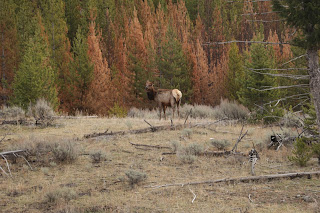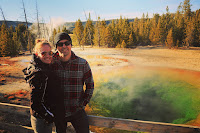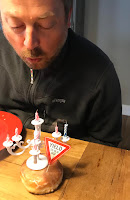Yellowstone - October 2016
Let me start by saying that Yellowstone has made a huge impression on us and that we're planning to visit this National Park (NP) during other seasons too in the future.
Yellowstone is a geological smoking gun! Although several destructing events took place at this area about half a million years ago, one event overshadows all others ... a huge area, that is now the center of the park, suddenly exploded. In minutes the landscape was devastated. At the center only a smoldering caldera remained, a collapsed crater of 45 by 30 miles. Lava flows and rocks from volcanic eruptions cover most of the land area of Yellowstone. So most of the park rests atop a slumbering volcano that is showing renewed activity by the way 😳 ... however no eruption is expected in the near future 😅
The boiling hot springs, fumaroles, mud spots and geysers spread out over the park are indeed reminders that such an event is not unimaginable!
In 1872 Yellowstone became the first National Park in the world!
As in all NPs, there are paved roads that cross the park with several viewpoints from where you're already treated with great views on the park, or from where hikes start to get the best out of what Yellowstone has to offer! However if you're planning a hike, be aware that Yellowstone is a unique eco-system with its special rules, ánd a wildlife sanctuary! So be ready to have an encounter with bisons, moose, elk, bighorn sheep, grizzly bear, black bear, wolves, mountain lion, and more! Carry bear spray (and know how to use it!) and make noise while hiking so the wildlife knows you're coming (they'll only attack you when they're surprised).
This first 3 day trip took place when the kids had a '2 day' fall break (so not a whole week of 'herfstvakantie' like in Belgium ... bummer 😆) at the end of October.
We left Utah with summer temperatures, and experienced our first winter temperatures there in Yellowstone. Although the park is open all-year round, access is limited during the fall, winter and spring due to these winter temperatures. In the beginning of November all roads close (with exception of the road between the North entrance and the North-East entrance) and they reopen from mid December to mid March for snowmobiles and snowcoach tours. As from the end of April the roads will gradually re-open for normal vehicles.
Primarily located in Wyoming, the park also extends into Montana (North & North-West) and Idaho (South-West), which are 3 states north of Utah. Our first stop was @ the West entrance of Yellowstone in Montana, which is a 4,5 hour drive from where we live.
Driving in the US really is a pleasure, and this has nothing to do with the good driving skills of the Americans 😏, but because of the great infrastructure which is so logical and because of the beautiful scenery you pass on these road trips!
... we returned to the park, to have an evening swim in the 'Boiling river'.
The water of a large hot spring flows out in to the otherwise cold waters of Gardner River at over 100 degrees (Celsius!)! It creates natural hot tubs in an ice cold river that is just too good to pass up. It's located close to the North entrance and you reach it after a short hike (1,25 miles round trip). You'll have to go through some ice cold water and rocky underground to reach the hot tubs area, but man it is worth it!
Our first stop was at the Grand Prismatic Hot spring, which is the largest hot spring in the US, and the 3th largest in the world. It is located in the Midway Geyser Basin. It's named because it's colors match the rainbow dispersion of white light by an optical prism: red, orange, green and blue. The hot water (65 to 85 degrees Celsius, so not swimmable 😅) is vibrant blue, with red color like lava surrounding it. However what looks like lava is actually pigmented bacteria. The color can range from green to red, and apparently the temperature can also determine what color the bacteria favors. For instance in the summer it will be more orange and in the winter rather dark green.
and gorgeous views, making the walk more enjoyable.
The Morning Glory pool is named after the flower that it's color resembled ... indeed past time ... the pools suffers from inconsiderate visitors who have thrown in coins, bottles, and trash into the pool for over a century. The trash has slowly built up and blocked some of the thermal vents and reduced the heath of the pool, allowing bacteria to begin working their way in at the edges, creating a red and yellow ring around the pure blue center. While these rainbow colors are indeed beautiful, it is a fragile beauty, as the invasive yellow bacteria continues to close in. Therefore the pool recently has started to go by another name ... 'Fading Glory' 😞
Food & lodging tips
Yellowstone is a geological smoking gun! Although several destructing events took place at this area about half a million years ago, one event overshadows all others ... a huge area, that is now the center of the park, suddenly exploded. In minutes the landscape was devastated. At the center only a smoldering caldera remained, a collapsed crater of 45 by 30 miles. Lava flows and rocks from volcanic eruptions cover most of the land area of Yellowstone. So most of the park rests atop a slumbering volcano that is showing renewed activity by the way 😳 ... however no eruption is expected in the near future 😅
The boiling hot springs, fumaroles, mud spots and geysers spread out over the park are indeed reminders that such an event is not unimaginable!
In 1872 Yellowstone became the first National Park in the world!
As in all NPs, there are paved roads that cross the park with several viewpoints from where you're already treated with great views on the park, or from where hikes start to get the best out of what Yellowstone has to offer! However if you're planning a hike, be aware that Yellowstone is a unique eco-system with its special rules, ánd a wildlife sanctuary! So be ready to have an encounter with bisons, moose, elk, bighorn sheep, grizzly bear, black bear, wolves, mountain lion, and more! Carry bear spray (and know how to use it!) and make noise while hiking so the wildlife knows you're coming (they'll only attack you when they're surprised).
This first 3 day trip took place when the kids had a '2 day' fall break (so not a whole week of 'herfstvakantie' like in Belgium ... bummer 😆) at the end of October.
We left Utah with summer temperatures, and experienced our first winter temperatures there in Yellowstone. Although the park is open all-year round, access is limited during the fall, winter and spring due to these winter temperatures. In the beginning of November all roads close (with exception of the road between the North entrance and the North-East entrance) and they reopen from mid December to mid March for snowmobiles and snowcoach tours. As from the end of April the roads will gradually re-open for normal vehicles.
Primarily located in Wyoming, the park also extends into Montana (North & North-West) and Idaho (South-West), which are 3 states north of Utah. Our first stop was @ the West entrance of Yellowstone in Montana, which is a 4,5 hour drive from where we live.
Driving in the US really is a pleasure, and this has nothing to do with the good driving skills of the Americans 😏, but because of the great infrastructure which is so logical and because of the beautiful scenery you pass on these road trips!
Day 1
The first day we explored the South part of the Park.
A few minutes after we entered the park, we were already in our first awe when we spotted a female elk (aka 'wapiti').
We were already used to seeing 'mule deer' (deer with big ears like a mule) and 'white tailed deer' (bambi 😉) in Utah on a regular basis (dead, on the side of the road 😔, and alive), but it was for all of us a first timer to see an Elk.
Elk have shaggy necks and are much taller (9 foot vs 3 to 4 foot) and heavier (1000 pound vs 100 to 300 pound) then the deers we are used to. Additionally deer don't make a lot of noise, while male elk are very vocal and produce extremely loud sounds, called 'bugling', to signal mating and distress. Lucky us, autumn is their mating season, so we were hoping to hear that very particular noise during our trip ... which we did on Day 2! 👏
Maybe important to note that 'deer' is a general term that covers the entire deer family to which the elk belongs, however the term is commonly used when specifically talking about 'bambi'. So an elk is a deer, but a deer is therefore not necessarily an elk 😏
Our first real stop was at the 'Gibbon falls',
but we made several small stops before arriving there as after each turn we made, the view was so magnificent ...
Our next big stop was the parking area bordering the North Rim trail where we first had some lunch.
We were already used to seeing 'mule deer' (deer with big ears like a mule) and 'white tailed deer' (bambi 😉) in Utah on a regular basis (dead, on the side of the road 😔, and alive), but it was for all of us a first timer to see an Elk.
Elk have shaggy necks and are much taller (9 foot vs 3 to 4 foot) and heavier (1000 pound vs 100 to 300 pound) then the deers we are used to. Additionally deer don't make a lot of noise, while male elk are very vocal and produce extremely loud sounds, called 'bugling', to signal mating and distress. Lucky us, autumn is their mating season, so we were hoping to hear that very particular noise during our trip ... which we did on Day 2! 👏
Maybe important to note that 'deer' is a general term that covers the entire deer family to which the elk belongs, however the term is commonly used when specifically talking about 'bambi'. So an elk is a deer, but a deer is therefore not necessarily an elk 😏
Our first real stop was at the 'Gibbon falls',
but we made several small stops before arriving there as after each turn we made, the view was so magnificent ...
... and because we were stopped by some natural habitants of the park, the bisons (although many people call them buffaloes, but those are only found in Africa and South Asia)! These up close encounters of bisons in the wild are so special! Especially if you realise that a male bison can weigh up to 2000 pounds (900 kg), but are still very agile and fast ... they can run up to 35 miles an hour ( 55 km/h)! No way for a human to outrun them! So you better treat them with the utmost respect, and only when you're in a car it is ok to be this close to the biggest mammal of North America.
Fun Fact
On May 9, 2016, President Obama signed the National Bison Legacy into law, officially making the bison the national mammal of the US, joining the ranks of the Bald Eagle as the official symbol of the US.
Our next big stop was the parking area bordering the North Rim trail where we first had some lunch.
From there it's a short walk on that trail to the 'Lookout point', As the trail was covered with snow/ice, we decided to put on our newly bought crampons (spikes that you can attach to your shoes). This, according to Geert completely excessive purchase 😆, proved to be very useful indeed! While other people were having difficulties to stay up right, we got to the view point fast, ánd graceful! I just love it when I can prove Geert wrong 😂
Anyway, the views into the 'Grand Canyon of Yellowstone' and the 308 foot Lower Falls are just stunning!
Via this North Rim Trail we also walked to 'Grand View point' from where we were again treated with gorgeous views.
This trail leads further to Inspiration point, but if you don't feel like walking, you can drive right up to these points (in the map below the dotted line represent the trail and the full line the road)
Another stop in this area that we can highly recommend is 'Artist Point'. It's located at the other side of the Yellowstone river, and gives another great view on the Lower fall.
From there we hiked towards Point Sublime, however due to lack of time we didn't go all the way. I don't know whether it was due to the snowy conditions, but we were all alone on this trail, and that's the way we love it! Although I have to admit, in bear country, it does add a special sensation to be all alone out there!
After this hike, we continued on the main road, passing again some gorgeous scenery!
Our next stop was at the Old Faithful geyser, but as we were just too late to witness the eruption (which takes place every 60 to 110 minutes), we would return here on our last day before heading back home.
Although it was getting late, we decided to make one last stop at the Fountain paint pots in the Lower geyser basin on our way back to our hotel at the West entrance. With the sun being gone, it was getting really cold, but this also gave it an extra special feeling ... the snow, the cold, the steam coming out of the ground, while it was getting dark ... it all created surreal views!
Perfect way to end our first day in this magical place!
Day 2
On our way to the Mammoth Hot Springs, our main destination of that day, we think we've spotted a wolf! We still don't know whether it really was a wolf, or 'just' a coyote ... but as it is pretty rare to spot a wolf, I really want to belief we did! 😏
As there were works going on the road going North, we had some delay (which we already took into account ... yep, we came prepared 😆), but having to wait to pass the single lane parts in such an environment (fauna & flora) is just not that terrible.
Before arriving at the springs, we had our lunch at the Sheepeater cliffs, massive rock columns formed by a lava flow 1?3 million years ago . A great place to picnic where the kids could get rid of some of their energy by climbing the rocks.
Mammoth Hot Springs is a large complex of hot springs on a hill of 'travertine', a form of limestone deposited by mineral springs. It was created as hot water from the spring cooled and deposited calcium carbonate. Because of the huge amount of geothermal vents, travertine flourishes here. When pure, travertine is white, but the algae living in the warm pools have tinted the travertine shades of brown, orange, red and green.
After our drive to the hotel in Gardiner, a little village at the North entrance of the park, we could add Pronghorns and Bighorn Rams on our list of spotted wildlife.
But what was even better, was that we got to hear the bugling of an elk, and we were even treated with the elk trying (yes trying, because the girls didn't seem like they were wanting him that day 😆) to mate! What a sight!!
After we checked in at our hotel, which by the way had a gorgeous view ...
The water of a large hot spring flows out in to the otherwise cold waters of Gardner River at over 100 degrees (Celsius!)! It creates natural hot tubs in an ice cold river that is just too good to pass up. It's located close to the North entrance and you reach it after a short hike (1,25 miles round trip). You'll have to go through some ice cold water and rocky underground to reach the hot tubs area, but man it is worth it!
We hiked back in the dark and returned completely relaxed to the village.
Day 3
On our last day we crossed the park from North to South via the West route (the East route was partially closed).
Although we already covered this route during our 2 first days, it was in the other direction this time, hence different views, and there were still enough stops we didn't do the first time (even after this second time we haven't seen everything ... by far!!).
 |
| Same route, different views |
We did the 'Midway Geyser basin trail', which leads you next to the spring, but due to the direction of the wind, we saw mainly steam and were not able to see the spring nor much of its vibrant colors. Nevertheless it was gorgeous!
But even if the wind direction is in your favor, I advice you to do the 'Grand Prismatic Hot Spring trail' instead, which leads you to the hills surrounding the spring, providing you a (better) view from above!
Our next stop was again the Old Faithful Geyser (stopped there also on day 1, remember?), but this time we arrived in time to witness it's eruption!
It's not the biggest geyser in Yellowstone or the most regular, however it is the biggest regular geyser 😆!
The Park Rangers are able to predicts its eruption fairly accurate which makes this one of the easiest 'geysers in action' to see! Check the NP website to see when it's eruption is expected to take place, and make sure you're there min 15 minutes before. I can only imagine how busy it is in the summer, but even when we were there, there were a lot of people wanting to see this eruption.
It's not the biggest geyser in Yellowstone or the most regular, however it is the biggest regular geyser 😆!
The Park Rangers are able to predicts its eruption fairly accurate which makes this one of the easiest 'geysers in action' to see! Check the NP website to see when it's eruption is expected to take place, and make sure you're there min 15 minutes before. I can only imagine how busy it is in the summer, but even when we were there, there were a lot of people wanting to see this eruption.
3700 To 8400 gallons (14000 to 30000 liter) of hot water is projected into the air, reaching an average height of about 145ft (44m) in about 15 to 20 seconds!
We opted to watch it from the benches located 300ft from the spout of the geyser, but you can also watch it from a higher vantage point after a hike up to Observation point.
It definitely is a 'must do', but I was more impressed by the Morning Glory pool which can be reached by a 1,5 mile paved path from the Old Faithful geyser. I would advice you to take the trail which leads you via several other geysers,
and gorgeous views, making the walk more enjoyable.
The Morning Glory pool is named after the flower that it's color resembled ... indeed past time ... the pools suffers from inconsiderate visitors who have thrown in coins, bottles, and trash into the pool for over a century. The trash has slowly built up and blocked some of the thermal vents and reduced the heath of the pool, allowing bacteria to begin working their way in at the edges, creating a red and yellow ring around the pure blue center. While these rainbow colors are indeed beautiful, it is a fragile beauty, as the invasive yellow bacteria continues to close in. Therefore the pool recently has started to go by another name ... 'Fading Glory' 😞
 |
| How it looked 50 years ago |
We drove back home continuing the road south through the park and via the Grand Tetons (another NP) & Jackson Hole. What we didn't realise was that this added another 2 hours to our travelling time back home! 😳
But just by passing through, we realised that we'll have to dedicate another trip to discover this area ...
- In West Yellowstone we stayed at the 'Stage Coach Inn', which is an ok hotel with an indoor pool, however without a bar 😏
- We had dinner at 'Madison crossing lounge' which is located next to our hotel and which was ok too ... however, take into account that we've already adjusted to the low culinary standard here, so don't expect too much from it!
- In Gardiner we stayed in the Best Western By Mammoth Hot Springs. The rooms are very simple, but clean and as I said before you get a gorgeous view.
- For dinner I think we went to 'The Raven Grill', but I'm really not sure ... that's what you get when you write you're blog months after the trip! It must have been (again) ok, because I would have remembered more if it would have been really good or really bad.
































































Comments
Post a Comment